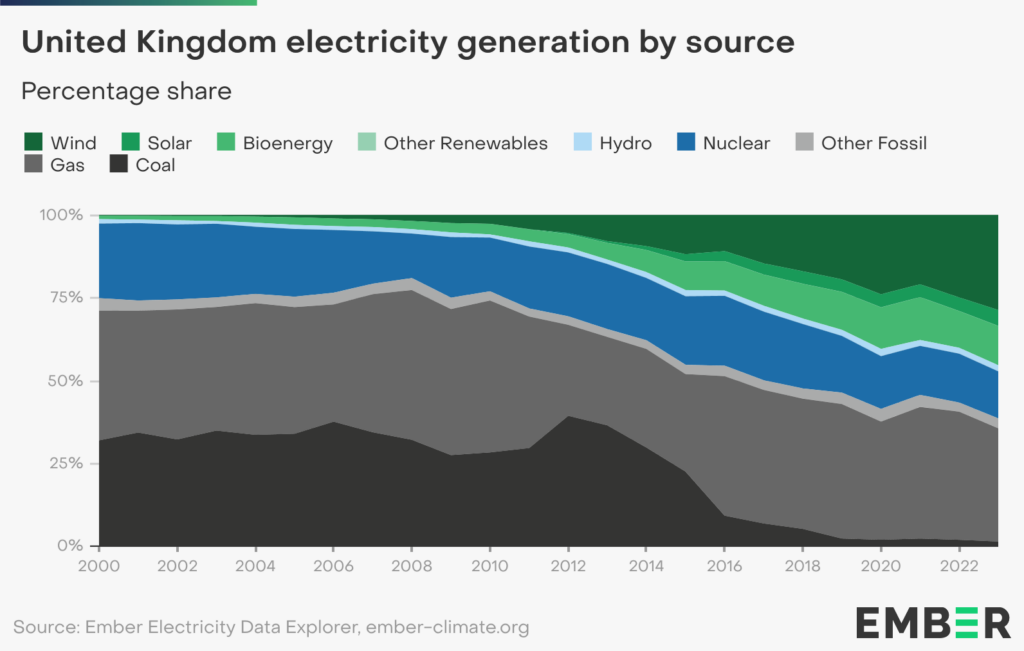This was a thing that had me scratching my head when prepping a few stories for a newsletter this weekend, and I figured it might be of use to others too.
In the UK, if you follow the decarbonisation of the grid, you’ll likely have noticed that the UK succeeded in getting coal off the grid at long last. The Carbon Brief, as ever has some fantastic coverage on this event.
I work somewhere where we care about a fossil free internet, and for a fossil free internet, you really want a fossil free grid, so I have something of a professional interest in this now.
So, this story in Bloomberg caught my eye – UK Gas Plants Are Hardly Running as Renewable Power Floods Grid (link, archive).
Here’s the choice quote:
In 2024, even during the most profitable hours, less than half of combined cycle gas turbines capacity were online, according to analysis by Kilowatt.io, a UK-based solar data company.
“Surprisingly, over half of the time this year, only around 20% of the CCGT capacity has been in operation,” Ben Watts, developer at Kilowatt.io said in a post on LinkedIn.
I am a fan of solar power, but I’m also aware that the source being cited here is a from a solar data company, so they’re likely to say things that put the solar in a positive light, and as far as I knew, the coal-based electricity generation in the UK was largely being displaced by a) Wind and b) Gas – not solar.
The headline is gives the impression that well… UK Gas Plants Are Hardly Running, but that’s not the same as what’s really happening. Let’s look at the data.
The chart below from Ember gives a good idea of how the mix has changed this century. Select United Kingsom, and then choose metric, and click percentage share. You’ll end up with a chart like this:

You can also look at Electricity Maps, as they provide a lot of extra detail. This screencap shows me sanity checking the same thing, but focussed on the last year.
Neither of these show gas barely running – in fact they show gas making up a pretty large chunk of the grid rarely less than 20% and sometimes higher than 80% in certain times of year.
So, is the solar data company lying? I don’t think so, and I think it’s worth taking a moment to understand.
So what is happening than?
In the UK there is lots and lots of capacity from combined cycle gas turbines CCGT, and they do not need to be running all the time to be profitable. Until I looked at this, I did not really have any intuition for how much capacity there was on the grid for gas to ramp up, and this is important when you think about a grid with more and more renewables on it because there will be times where the wind does not blow and the sun does not shine.
Previously I thought this was largely served by something called “peaker” or single-cycle gas plants which are less efficient than CCGT ones, but are only on for single digit percentages of the year. The thing is, in many parts of the world they come on when the cost of power is so high that they can make enough money from that tiny percentage of the time they operating to be profitable.
Some parts of the world though also pay these gas plants to be available just in case – these are called capacity payments. The UK and Germany do this. Peakers are not expected to run for days or even weeks at a time – they only come on for short periods, and in many cases, they are good candidates for replacement by energy storage from batteries.
CCGTs which make up the bulk of gas-fired generation hours however are supposed to run for longer periods – these are less obvious candidates for replacement by batteries alone. This is because the default choice of batteries, Lithium-ion ones are largely used in configurations where they offer up to around 4 hours of storage. This is changing however, with new battery chemistries that are different to lithiuim, like Iron-Air, or Sodium.
Anyway, in summary, yes, the UK grid is decarbonising, and at the same time, yes, in 2024 is using loads of gas on the grid still. However, this is likely to change with the new government in the UK, as they have made some extremely bold, and ambitious statements about wanting an entirely fossil free grid by 2030.
Precisely how they’ll do that is the subject of another post though – til then, hope this helped!
Leave a Reply